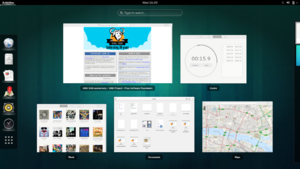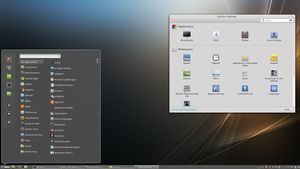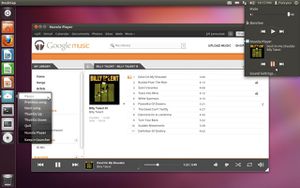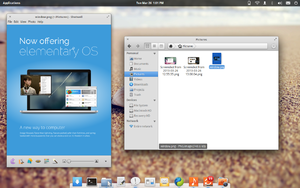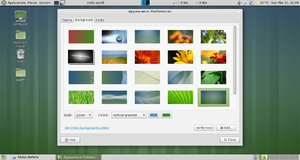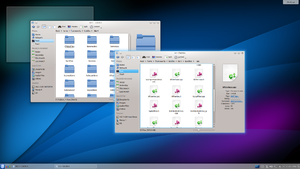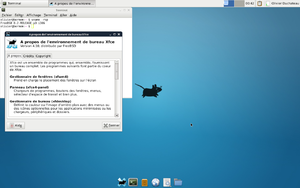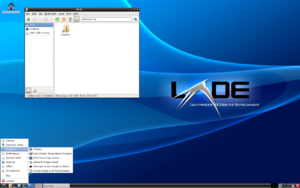We are still actively working on the spam issue.
Difference between revisions of "Choosing a Distro"
(Ubuntu) |
|||
| Line 122: | Line 122: | ||
[[Linux From Scratch]] | [[Linux From Scratch]] | ||
| + | |||
| + | [[FreeBSD]] | ||
== Desktop Environments == | == Desktop Environments == | ||
Revision as of 14:24, 15 February 2014
Page status: outline
To-do: Flesh out descriptions and shit, add photos of DEs
Before researching and choosing the right distrobution for you, you must have in mind what you want to use it for. Facebook machine? Programming? Gaming (lel)? A secondary consideration is hardware. Linux generally tends to play well with underpowered or aging computers, but you may want to try lighter distros.
There are three things you want to compare when distro shopping.
1. Distro quirks
3. Application library
Contents
Distro families
For more information, visit each distro's homepage, Wikipedia, and DistroWatch.
Debian
A community-developed distro focused on stability. Has the biggest user base if you include distros based on it. Comes in various releases with different tradeoffs of stability/up-to-datedness. More or less the most important distro.
Ubuntu
Takes Debian Testing, makes sure its packages are usable, adds drivers, adds handholding, and adds spyware. Not to fear, it's easily removable ([fixubuntu.com]). Comes with Unity by default. Repo is supplemented with user-maintained PPAs, so if it's available for Linux you can probably find it here. The most popular desktop distro with the most guides and solutions on various forums.
Developed by Canonical, the evil empire of the free software world.
Mint
Takes Ubuntu, removes spyware, adds proprietary shit like Flash right in the iso. Developed the MATE and Cinnamon desktop environments. Uses Ubuntu repos.
elementaryOS
Takes Ubuntu and makes it look like OS X by developing the Pantheon desktop environment and in-house programs. Uses Ubuntu repos.
Crunchbang
Takes Debian Stable and rices it for you. Openbox, Tint2, the works. Comes with drivers. Uses stable and backport Debian repos.
Fedora
Developed by Red Hat, probably the biggest corporate backer of GNU/Linux, as a testing bed for its commercial RHEL distro. Bleeding edge - usually the first major distro to start shipping with new developments such as Wayland.
OpenSUSE
Developed by Novell as a testing bed for its commercial SUSE distro. Best implementation of KDE, and great GNOME integration. Has a well-regarded integrated configuration tool called YaST.
Arch
A community-developed distro focused on simplicity and vanilla-ness of its underlying parts. No handholding or preconfigured defaults - setting up the system is left to the user. Has the most bleeding-edge packages, so be prepared for the possibility of things breaking when you update. Great for learning how a GNU/Linux system comes together.
Manjaro
Takes Arch, preconfigures everything, and gives it an easy graphical installer. Also maintains its own repo of more stable packages in addition to the Arch repos.
Gentoo
Install it.
Slackware
Other
Mageia
PCLinuxOS
Puppy
How new r u
babby's first loonix
Ubuntu has been the go-to distro for new GNU/Linux users for several years. Unfortunately, the developers have recently made some choices that do not reflect the best interests of users or the wider GNU/Linux ecosystem. Ubuntu ships with spyware that sends your desktop searches to Amazon for the purpose of displaying ads in your search results. It is highly recommended to follow the steps at [fixubuntu.com] immediately upon installation. Despite this, it is still a solid distro for newcomers and continues to be extremely popular with desktop users, with a great support community.
Mint
Elementary
DEs:Any
Reasonably experienced
Crunchbang
Now you can do WMs
Neckbeard tier
Desktop Environments
Gnome 3
Cinnamon - Mint
Unity - Ubuntu
http://www.ubuntu.com/tour/en/
Pantheon - Elementary
MATE (Gnome 2) - Mint
XFCE
LXDE
Enlightenment
Window Managers
Explanation of stacking/tiling shit
Stacking
Openbox
the rest/who cares
Tiling
AwesomeWM
dwm
xmonad
the rest/who cares
